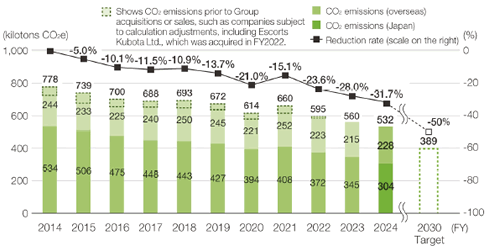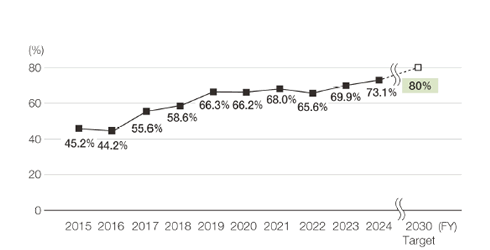Medium- and Long-Term Environmental Conservation Targets and Results
In order to promote environmental management in light of various recent social developments, such as SDGs and the Paris Agreement, as a sustainable company, the Kubota Group has challenged itself to achieve zero environmental impact in its Environmental Vision for 2050. Moreover, to promote systematic reduction of environmental impacts, we have been promoting environmental activities by formulating our medium- and long-term targets for environmental conservation. Toward achieving these targets, the Group is advancing systematic initiatives in both the production and product development stages.
Long-Term Environmental Conservation Targets 2030 and Results
1. Mitigating and Adapting to Climate Change
The shift to a decarbonized society has been accelerated, with each country declaring substantially zero emissions of CO2 and carbon neutrality. In its Environmental Vision, the Kubota Group announced its commitment to take up the challenge of achieving carbon neutrality by 2050. Based on these global trends and the image for the company expected by society in the future, in our Long-Term Environmental Conservation Targets 2030, in 2022 we expanded the boundary of our CO2 reduction target from the Kubota Group in Japan to a global boundary, and revised our target upward. We will continue energy saving to reduce energy consumption at our sites, reduce CO2 emissions through fuel conversion by adopting electric furnaces and so forth, and by expanding our use of renewable energies, we will promote initiatives to achieve carbon neutrality.
| 2030Targets | Reduce CO2 emissions from the Kubota Group* by 50% compared to the base year FY2014. |
|---|---|
| Result | In FY2024, CO2 emissions of the Kubota Group* were reduced by 31.7% compared to the base year FY2014. |
- CO2 emissions refer to Scope 1 and 2 emissions from all Kubota Group sites (100%) and include greenhouse gases from non-energy sources
Results for Long-Term Environmental Conservation Targets
-
Kubota Group Scope 1 and 2 CO2 Emissions*1

-
Sales Ratio of Eco-Products*2,3

- *1.CO2 emissions of companies that have been acquired or sold that significantly impact overall Group emissions have been adjusted retroactively to before the acquisition or sale. Namely, Great Plains Manufacturing, Inc. (acquired in 2016), Escorts Kubota Ltd. (acquired in 2022), and P.T. Metec Semarang (sold in 2017). The CO2 emissions before adjustments are 714 kilotons CO2e in 2014, 674 kilotons CO2e in 2015, 647 kilotons CO2e in 2016, 645 kilotons CO2e in 2017, 647 kilotons CO2e in 2018, 630 kilotons CO2e in 2019, 570 kilotons CO2e in 2020, 613 kilotons CO2e in 2021, and 585 kilotons CO2e in 2022. In FY2023 we had no acquisitions or sales subject to adjustments.
- *2.The sales ratio of products that have fulfilled the internal requirements in our own Eco-Products Certification System Sales ratio of Eco-Products (%) = Sales of Eco-Products / Sales of products (excluding construction work, services, software, parts and accessories) × 100
- *3.From FY2023, sales of the ceramic material TXAX have been excluded from the calculations because TXAX is considered to be a component. If TXAX was included, the FY2023 sales ratio of eco-products would come to 69.9%.
2. Efforts to Develop Environment-conscious Products
| Goal | Increase the sales ratio of Eco-Products* to 80% by 2030. Aim to put all new products which are certified as Eco-Products in the market in 2030 and later. |
|---|---|
| Result | The sales ratio of Eco-Products was 73.1% in FY2024. |
- *1. The sales ratio of products that have fulfilled the internal requirements in our own Eco-Products Certification System Sales ratio of Eco-Products (%) = Sales of Eco-Products / Sales of products (excluding construction work, services, software, parts and accessories) × 100
- *2. From FY2023, sales of TXAX, the ceramic material have been excluded from the calculations because TXAX is considered to be a part. If TXAX was included, the FY2023 sales ratio of eco-products would come to 69.9%.
Medium-Term Environmental Conservation Targets and Results
Since FY2021 we have been undertaking initiatives with the aim of achieving our Medium-Term Environmental Conservation Targets 2025. And so that we can continuously make improvements, we have also established a set of targets for the year 2030. We intend to systematically roll out initiatives aimed at achieving our targets, at our production sites and product development.
| Reporting Boundary | Issue | Action item | Management indicator*3 | Base FY | Target for FY2025*9 | Target for FY2030*9 | FY2024 Result |
|---|---|---|---|---|---|---|---|
| Global Production Sites | Mitigating and Adapting to Climate Change | Reduce CO2*1 | CO2 emissions per unit of production (Scopes 1, 2) | 2014 | ▲45% | ▲60% | ▲46.1% |
| Ratio of renewable energy usage*4 | — | 20% or more | 60% or more | 13.2% | |||
| Save energy | Energy consumption per unit of production | 2014 | ▲35% | ▲40% | ▲38.6% | ||
| Working towards a Recycling- based Society | Reduce waste | Waste discharge per unit of production | 2014 | ▲45% | ▲50% | ▲53.7% | |
| Hazardous waste discharge per unit of production*5 | 2019 | ▲17% | — | ▲21.8% | |||
| Recycling ratio (Japan) *6 | — | Maintain 99.5% or more | — | 99.5% | |||
| Recycling ratio (Overseas) *6 | — | Maintain 90.0% or more | — | 95.7% | |||
| Conserving Water Resources | Conserve water resources | Water withdrawal per unit of production | 2014 | ▲35% | ▲40% | ▲40.4% | |
| Controlling Chemical Substances | Reduce VOCs*2 | VOC emissions per unit of production | 2014 | ▲42% | — | ▲42.5% | |
| Products | Improving Products’ Environmental Performance | Expand Eco-Products |
Sales ratio of Eco-Products*7 | — | 70% or more | — | 73.1% |
| Efficient resource use | Usage ratio of recycled materials*8 | — | Maintain 70% or more | — | 85.2% |
| Reporting Boundary |
Issue | Action item | Management indicator | Reference ESG Report 2025 |
|---|---|---|---|---|
| Global Production Sites |
Working towards a Recycling-based Society |
Improve resource efficiency |
• Reduce disposable plastics at business sites | See p.55 |
| • Work with suppliers to conserve packaging materials and make them returnable | ||||
| • Implement paperless operation | ||||
| Conserving Water Resources |
Control wastewater | • Manage wastewater appropriately in accordance with the standards of the water discharge by operating wastewater treatment facilities and water recycling facilities, etc. | See p.57 | |
| Conserving Biodiversity |
Conserve biodiversity at business sites |
• Promote the protection of the natural environment by greening our establishments and creating biotopes | See p.71 | |
| Promote social contribution activities | • Promote conservation of the local natural environment and biodiversity as social contribution activities | See p.72 | ||
| Products | Improving Products' Environmental Performance |
Efficient resource use | • Display the material of new parts and provide material information*10 | Currently in progress*12 |
| Develop vehicles compliant with exhaust gas regulations |
• Development of industrial diesel engines that comply with the latest emissions regulations (Stage V), and launch onto the market of products with such engines*11 • Launch the vehicles that comply with the latest emissions regulations onto the market |
See p.75 |
- *1. CO2 emissions indicate 90.6% of base-year Scope 1 and 2 emissions and include greenhouse gases from non-energy sources. We use the emissions coefficient for electric power of the base year in our calculation of CO2 emissions from energy sources.
- *2. VOCs (volatile organic compounds) refer to the substances that are most prevalent in the emissions of the Kubota Group. Up until 2022, there were six substances: xylene, toluene, ethylbenzene, styrene, 1, 2, 4-trimethylbenzene, and 1, 3, 5-trimethylbenzene. Since FY2023 there have been five substances: xylene, toluene, ethylbenzene, styrene, and trimethylbenzene.
- *3. The figures per unit of production represent the intensity of the environmental load per unit of money amount of production. The exchange rate for FY2014 is used when translating the money amount of production of overseas sites into Japanese yen.
- *4. The applicable boundary is global sites.
- *5. In Japan, specially controlled industrial waste as defined in the Waste Management and Public Cleaning Law; Overseas, waste that is defined as hazardous in each country or region.
- *6. Recycling ratio (%) = (Sales amount of valuable resources + External recycling amount) / (Sales amount of valuable resources + External recycling amount + Landfill disposal) × 100. Heat recovery is included in the external recycling amount.
- *7. The sales ratio of products that have fulfilled the internal requirements in our own Eco-Products Certification System Sales ratio of Eco-Products (%) = Sales of Eco-Products / Sales of products (excluding construction work, services, software, parts and accessories) × 100
- *8. Usage ratio of recycled materials (%) in the cast metal products and parts manufactured by the Kubota Group (ductile iron pipes, fittings, machine cast products (engine crankcase, etc.)). Since FY2023, old pig iron generated at the same business sites has been excluded from the calculation.
- *9. ▲ indicates a negative figure.
- *10. In accordance with internal standards, we provide information on materials through material labeling and specification sheets for plastic components.
- *11. Targeting tractors and combine harvesters (output range: 56 kW ≤ P < 560 kW) equipped with engines compliant with the European emissions regulations (Europe Stages IV and V) level, shipped to Europe, North America, Japan, and Korea
- *12. Due to the reorganization or new establishment of businesses, our internal standards regarding the method of providing material information have been developed. These standards were into operation from 2023.
Next Medium - and - Long Term Environmental Conservation Targets
| Reporting Boundary |
Issue | Action item | Management indicator | Base FY | Target for FY2030 | Target for FY2040 | ||
|---|---|---|---|---|---|---|---|---|
| Global Production Sites |
Mitigating and Adapting to Climate Change | Reduce CO2 | CO2 emissions | 2014 | ▲50% | ▲75% | (New) | |
| 2023 | ▲30% | ― | ||||||
| CO2 emissions per unit of production (Scopes 1, 2) | 2014 | ▲60% | ― | |||||
| Ratio of renewable energy usage | ― | 60% or more | ― | |||||
| Save energy | Energy consumption per unit of production | 2014 | ▲45% | (Update) | ― | |||
| Working towards a Recycling-based Society | Reduce waste | Waste discharge per unit of production | 2014 | ▲60% | (Update) | ― | ||
| Hazardous waste discharge per unit of production | 2019 | ▲35% | (New) | ― | ||||
| Recycling ratio | ― | 96% or more | (New) | ― | ||||
| Conserving Water Resources | Conserving water resources | Water withdrawal per unit of production | 2014 | ▲45% | (Update) | ― | ||
| Controlling Chemical Substances | Reduce VOCs | VOC emissions per unit of production | 2014 | ▲42% | (New) | ― | ||
| Products | Improving Products' Environmental Performance | Expand Eco-Products | Sales ratio of Eco-products | ― | 80% | ― | ||